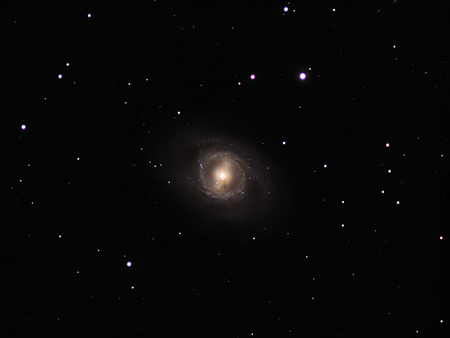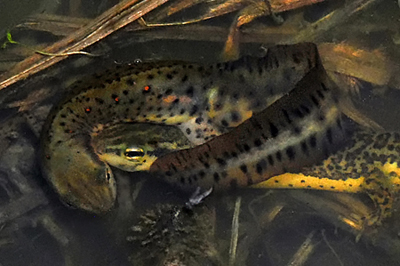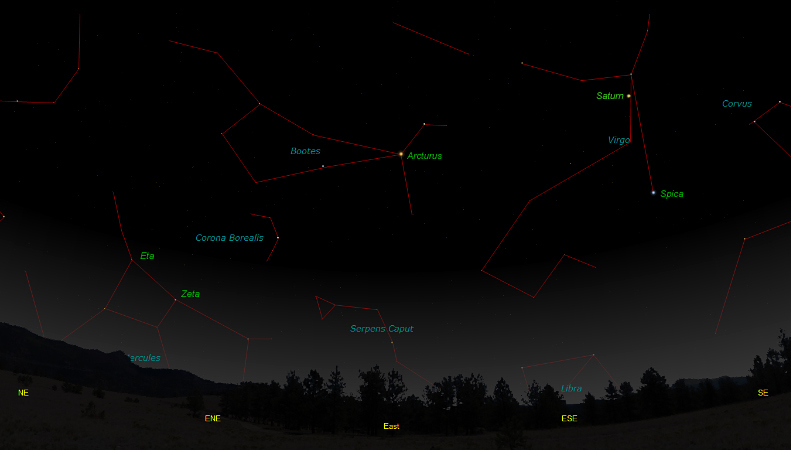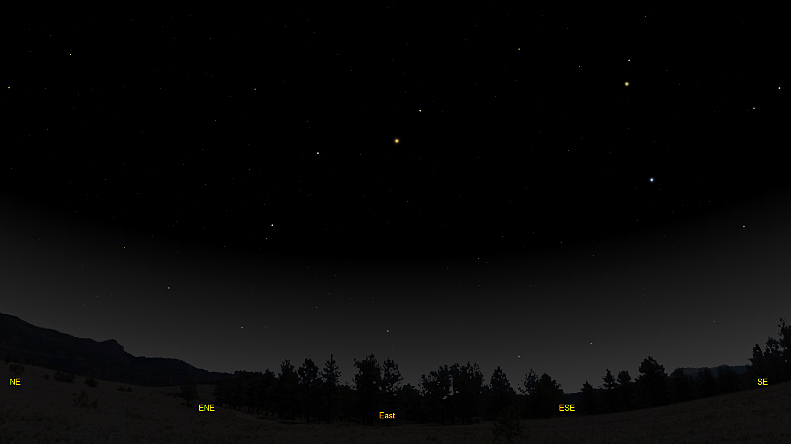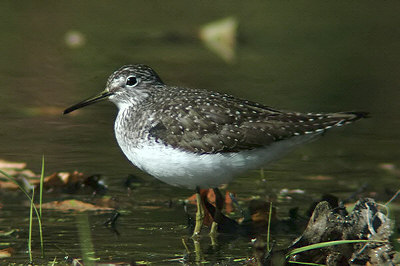The purpose of this feature is to give scout leaders, educators and naturalists an idea of some of the natural events coming up each month. We will try to cover a variety of natural events ranging from sky events to calling periods of amphibians, bird and mammal watching tips, prominent wildflowers and anything else that comes to mind. We will also note prominent constellations appearing over the eastern horizon at mid-evening each month for our area for those who would like to learn the constellations. If you have suggestions for other types of natural information you would like to see added to this calendar, let us know! Note: You can click on the hyperlinks to learn more about some of the featured items. To return to the Calendar, hit the "back" button on your browser, NOT the "back" button on the web page. All charts are available in a "printer friendly" mode, with black stars on a white background. Left clicking on each chart will take you to a printable black and white image. Please note that images on these pages are meant to be displayed at 100%. If your browser zooms into a higher magnification than that, the images may lose quality. Though we link book references to nationwide sources, we encourage you to support your local book store whenever possible. Notes and Images From March 2011
After a period of rain at the end of February, the sky cleared on the evening of March 1st. The ground around the telescope was soggy, but the clouds held off until the following morning. I've always liked barred spiral galaxies, so I decided to image Messier 95 in Leo. The evening was cool. While I was setting up the scope, Upland Chorus Frogs and Southern Leopard Frogs called from our pond, but the calls were very slow. A Barred Owl called twice from across the railroad tracks. The telescope took images until dawn, and finished up just as the clouds rolled back in. The form of this galaxy is interesting, with the inner spiral arms forming a tight ring around the nucleus before extending into the outer halo. The shape of the galaxy has been compared to one of the fighter ships in the first Star Wars movie. Messier 95 is about 38,000,000 light-years distant. For a higher resolution view and more about the galaxy and the image, click here.
Love in the Shallows: We came across these courting Red-spotted Newts in our pond on March 27th. These newts are common in small ponds, swamps, lakes, ditches and sluggish streams in our area. The Red-spotted Newt is a subspecies of the Eastern Newt, Notophthalmus viridescens. In the image at right an adult male newt clasps a female with his back legs and positions his body so that the female's snout presses against special glands on his cheek. Simultaneously, the male fans the female's head with his tail, wafting secretions from beneath his tail. The male may fan the female in this position for over an hour. Even then, the female may swim away after the male releases her, leaving the mating process incomplete.
The life cycle of the newt is interesting in that it usually consists of four separate stages; egg, aquatic larva, terrestrial red eft, and aquatic adult. The incubation period for the eggs is from 20 to 35 days, depending on the water temperature. The gilled aquatic larvae feed on small invertebrates. Aquatic larvae that transform to the eft stage (some transfer directly to a gilled adult), do so after 2-5 months. The red eft is a terrestrial stage. The eft leaves the pond and travels to forested habitat, where it forages for invertebrates among the leaf litter. Efts tracked in one study required about one year to migrate 800 meters to a forested area. The eft stage can last from 2 to 7 years. Efts can range in color from brownish to bright orange. Efts in coastal populations are not as brightly colored as those found at higher elevations. The eft imaged above was found on the Cumberland Plateau. The bright color is a warning to potential predators; the skin of efts contains toxins that may be harmful or fatal to small animals. Among the animals said to avoid them are Raccoons, American Toads, Garter Snakes, Killdeers and Red-tailed Hawks. The skin of red efts is said to be more than 10 times more toxic than the skin of adult newts. After 2 to 7 years in a forested habitat, the efts migrate back to the pond from which they came. In doing so they exhibit a remarkable homing instinct. Upon reaching the pond they transform to the adult aquatic form and are ready to start the breeding cycle. Adult male newts have been known to live up to 15 years and females up to 12 years.1 The words eft and newt come from variations on the Old English "efete" and a Middle English variation, "ewte". The phrase "an ewte" became "a newt". 1Information for the above paragraphs taken from Petranka, James W. 1998, Salamanders of the United States and Canada, Smithsonian Institution Press, 587pp. Sky Events for April 2011: The Lyrid Meteor Shower will peak around the mornings of April 22nd and April 23rd. Most years this is a fairly weak shower, with only 10 to 20 meteors visible under ideal conditions. The shower is occasionally richer, however. This year the light of the waning gibbous moon will tend to interfere with observations. Evening Sky: Beautiful Saturn rises around 7:09pm CDT on April 1st in Virgo. Best telescopic views occur when the planet is due south around 1:00am. Just about any small telescope will give a wonderful view. Morning Sky: Venus is a brilliant point of light in the southeast predawn sky. The planet rises around 5:09am CDT at the beginning of the month. On April 30th, a thin waning crescent Moon will be above Venus at dawn, and using binoculars you may be able to spot Mercury and Jupiter low and to the left (north) of Venus. Begin about 30 minutes before sunrise (about 5:26 CDT) and quit searching at sunrise, to prevent injuring your eyes from an unexpected solar encounter. All times noted in the Sky Events are for Franklin, Tennessee and are Central Daylight Time. These times should be pretty close anywhere in the mid-state area. Constellations: The views below show the sky looking east at 9:30pm CDT on April 15th. The first view shows the sky with the constellation outlined and names depicted. Star and planet names are in green. Constellation names are in blue. The second view shows the same scene without labels. Bright objects in the eastern sky this month include the stars Arcturus and Spica, and the planet Saturn. New constellations are Serpens Caput, the Serpent (Head), and Hercules, the Strongman. As spring progresses and Hercules rises higher in the sky, look for the globular cluster Messier 13 (M13), which appears like a small fuzzy patch of light about 1/3 of the distance from Eta to Zeta Hercules (see illustration below). A cluster of stars about 21,000 light years away, M13 can be made out with the naked eye in a dark country sky when the constellation is high in the sky. Binoculars will help pick it out.
On Learning the Constellations: We advise learning a few constellations each month, and then following them through the seasons. Once you associate a particular constellation coming over the eastern horizon at a certain time of year, you may start thinking about it like an old friend, looking forward to its arrival each season. The stars in the evening scene above, for instance, will always be in the same place relative to the horizon at the same time and date each April. Of course, the planets do move slowly through the constellations, but with practice you will learn to identify them from their appearance. In particular, learn the brightest stars (Like Arcturus and Spica in the above scene looking east), for they will guide you to the fainter stars. Once you can locate the more prominent constellations, you can "branch out" to other constellations around them. It may take you a little while to get a sense of scale, to translate what you see on the computer screen or what you see on the page of a book to what you see in the sky. Look for patterns, like the stars that make up the constellation Corona Borealis. The earth's rotation causes the constellations to appear to move across the sky just as the sun and the moon appear to do. If you go outside earlier than the time shown on the charts, the constellations will be lower to the eastern horizon. If you observe later, they will have climbed higher. As each season progresses, the earth's motion around the sun causes the constellations to appear a little farther towards the west each night for any given time of night. If you want to see where the constellations in the above figures will be on May 15th at 9:30pm CDT, you can stay up till 11:30pm CDT on the April 15th and get a preview. The westward motion of the constellations is equivalent to two hours per month. Recommended: Sky & Telescope's Pocket Star Atlas is beautiful, compact star atlas. It is destined to become a classic, and is a joy to use at the telescope. A good book to learn the constellations is Patterns in the Sky, by Hewitt-White. You may also want to check out at H. A. Rey's classic, The Stars, A New Way to See Them. For skywatching tips, an inexpensive good guide is Secrets of Stargazing, by Becky Ramotowski. A good general reference book on astronomy is the Peterson
Field Guide,
A Field Guide to the Stars and Planets, by Pasachoff. The book retails for around $14.00. Starry Night has several software programs for learning the night sky. Visit the Starry Night web site at www.starrynight.com for details.
Amphibians:
Already this spring we've heard Upland Chorus Frogs, Spring Peepers, Southern Leopard Frogs,and American Toads. Listen for Gray Treefrogs. The early calls of Gray Treefrogs sound raspier than the normal trill, as if the frog needs to clear its throat. They sometimes call from small tree cavities on warm days. Listen also on warm days for Northern Cricket Frogs, American Bullfrogs, and Green Frogs. Early April is also a great time to listen for the "yeeooww" calls of Pickerel Frogs. Recommended: The Frogs and Toads of North America, Lang Elliott, Houghton Mifflin Co.
Birds:
The spring migration builds very quickly in April. The neo-tropical migrants are too numerous to list here, but now is the time to get out in the early morning with a pair of binoculars and welcome the new arrivals for the day. Scan the edges of ponds and creeks for Solitary and Spotted Sandpipers. Early arrivals also include Black-and-white Warbler, Black-Throated Green Warbler, Louisiana Waterthrush and Blue-gray Gnatcatcher. Listen at dusk for young Great Horned Owls and Young Barred Owls, doing their raspy "begging" calls. Recommended: The Sibley Guide to Birds, David Allen Sibley The Sibley Guide to Birds of Eastern North America, David Allen Sibley An inexpensive guide for beginners is the Golden Guide for Birds.
Wildflowers: Some of our favorite Spring wildflower walks are: The south ridge at the Owl's Hill Nature Center in Brentwood, Tennessee. The Edwin Warner paved loop at the Warner Parks in Nashville or just about any trail in Warner Parks. The Angel Falls trail along the Cumberland River at the Big South Fork Recreational Area, near Jamestown, Tennessee.
Archives (Remember to use the back button on your browser, NOT the back button on the web page!) Natural Calendar February 2011 Natural Calendar December 2010 Natural Calendar November 2010 Natural Calendar September 2010 Natural Calendar February 2010 Natural Calendar December 2009 Natural Calendar November 2009 Natural Calendar September 2009 Natural Calendar February 2009 Natural Calendar December 2008 Natural Calendar November 2008 Natural Calendar September 2008 Natural Calendar February 2008 Natural Calendar December 2007 Natural Calendar November 2007 Natural Calendar September 2007 Natural Calendar February 2007 Natural Calendar December 2006 Natural Calendar November 2006 Natural Calendar September 2006 Natural Calendar February 2006
Natural Calendar
December 2005
Natural Calendar
November 2005
Natural Calendar
September 2005
Natural Calendar
February 2005
Natural Calendar
December 2004
Natural Calendar
November 2004
Natural Calendar
September 2004
Natural Calendar
February 2004
Natural Calendar
December 2003
Natural Calendar
November 2003
Natural Calendar
September 2003 Natural Calendar February 2003 Natural Calendar December 2002 Natural Calendar November 2002 Nature Notes Archives: Nature Notes was a page we published in 2001 and 2002 containing our observations about everything from the northern lights display of November 2001 to frog and salamander egg masses. Night scenes prepared with The Sky 6 Professional from Software Bisque All images and recordings © 2011 Leaps |
|||||||||||||
